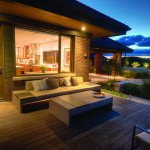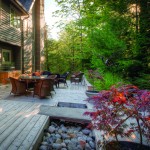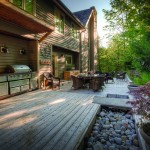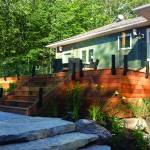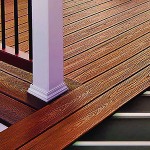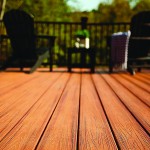Making the most of outdoor living
story by Judy Ross
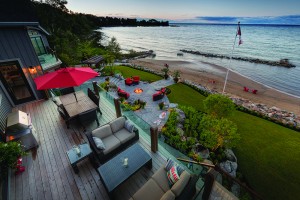
Of all worthwhile home investments, perhaps the one that gives the most enjoyment is a deck added to the back of the house. If designed and built well, it will offer a pleasing architectural element to the back yard as well as extra outdoor living space. In summer it will enhance your garden and become a favourite place to dine, lounge and entertain.
Then, when the leaves start to fall, the deck takes on a campfire vibe as you gather around an outdoor fire pit. In winter, an integrated hot tub steps away from the house will keep you outside on the coldest of nights. Year-round outdoor living has never been so good.
BEFORE YOU BUILD
If you plan to build a deck yourself, first contact the utilities companies to identify gas, power and water lines. Then check zoning by-laws and building permit requirements. You will probably need a permit. “We won’t build a deck without a permit,” says Chris Cayley, owner of the Hickory Dickory Decks franchise in Collingwood and Wasaga Beach. “Getting one protects the homeowner; it means the local municipality is inspecting every stage of the construction.”
A good way to get a sense of the deck coverage is to first stake the area. The combination of your house and deck can only cover 80 per cent of your property. In other words, if you have a big house on a small property, there won’t be much allowable room for a deck. Staking also allows you to gauge the path of the sun. You may be able to angle the deck or add a wraparound section to get more or less sun (or wind).
Think about how you want to use your deck. For outdoor dining you’ll want to have the deck close to the kitchen and have space for the barbecue and perhaps a planter full of herbs. Consider whether a bistro table for two is all you need, or whether you require a table big enough to feed a crowd. If kids are involved, make room for things like a built-in sandbox, toy chest and some small-people furniture.
For entertaining, create a series of rooms on different levels, each one serving a different purpose. Pay attention to the flow of movement and have clear paths for people to get from one area to another. Plan ahead if you want to take advantage of high-tech innovations like outdoor sound systems and weather-resistant LCD television sets.
DESIGNING YOUR DECK
Andrew Lansdale, a landscape designer with The Landmark Group, says it’s important to match the deck style with the architecture and interior of your house. “You’ll want that feeling of carrying the space from inside to outside,” he notes, adding, “With contemporary houses we use a lot of glass panels and steel cable railings.” A more traditional or country-style house may suit a deck that features white pickets, decorative post caps and built-in pergolas and benches.
If your deck is less than two feet off the ground you won’t need railings (or a permit). And always go big if you can. Ryan Baker of Springscapes Landscaping in Stayner builds a lot of decks for clients and maintains that the best way to add style and space to your deck is to build it in tiers with varying levels. “It will look a lot more interesting,” he maintains. “You’ll get more usage and it won’t add too much more to the cost.”
Night-time ambiance can be created with innovative new outdoor lighting. You can make your deck and stairs safe with low-voltage fixtures that cast light downwards and then put up some rope lighting (a string of low intensity lights fitted into clear PVC tube) for interesting accents. Uplights in shrubs and trees that surround the deck extend the feeling of space. For further comfort, there are patio heaters to keep you warm on cold nights, and misting fans to cool you off in summer.
MATERIAL CHOICES
Wood
The question usually comes down to either pressure-treated or cedar. Pressure-treated lumber is the most economical. Made of yellow pine, it has had a chemical preservative forced into the wood cells under pressure. Many builders are now using ‘brown’ pressure treated lumber, a new product that, unlike the original green-tinged wood, looks like cedar.
Cedar is still a popular, if more costly, choice. It’s a soft wood that is aromatic and contains natural oils and tannins that are somewhat resistant to rot. It is durable and quick to weather to a silver-grey colour. Some form of treatment or sealing is recommended. To save money, cedar can be used for the decking and posts, but the substructure can be built with less costly pressure-treated lumber.
Ipe and other exotic woods from South America are the frequent – and expensive – choice of high-end clients, according to local landscape architects. Ipe is very dense and labour-intensive to install, but it has a lovely finish and will last longer than cedar.
Composite Materials
Advances in decking materials have made this option far more attractive (and less plastic-looking) than it was in the ’80s and ’90s. Composite decking is created by mixing polyethylene with wood fibre and other fillers. The boards look and feel like wood but are low maintenance, won’t fade or stain, and never need to be painted, stained or sealed.
“We deal with about 15 different suppliers of composite decking,” says Chris Cayley, “and we use composite in 90 per cent of the decks we build.” While composite costs more than wood up-front, Cayley says it pays for itself because it comes with a lifetime warranty.
Steel
A new product that is making a difference in deck building is helical piles, manufactured steel foundation posts that screw into the soil. “These are much more efficient than putting in concrete footings,” maintains Cayley, who uses these steel posts in more than half of the decks he builds. “They cost more money, but it speeds things up so you can save on time and labour costs.”
For return on investment, outdoor living rooms have now replaced kitchens and bathrooms as the best place to put your home improvement dollars, according to real estate experts. That means more outdoor fun now and a bigger bang for your buck when you sell your house. A worthwhile investment, indeed. ❧







